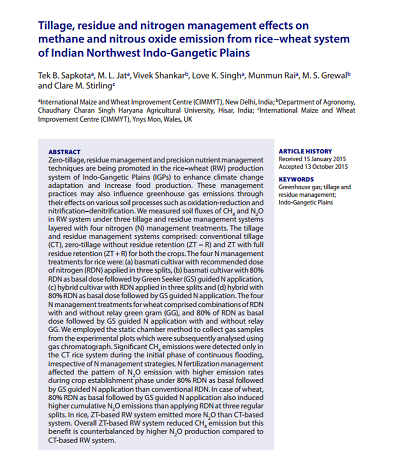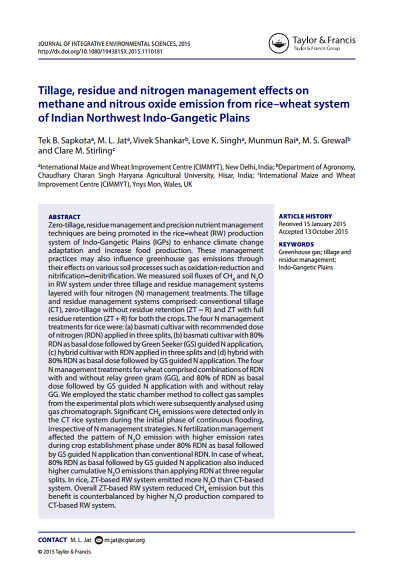

Zero-tillage, residue management and precision nutrient management techniques are being promoted in the rice–wheat (RW) production system of Indo-Gangetic Plains (IGPs) to enhance climate change adaptation and increase food production. These management practices may also influence greenhouse gas emissions through their effects on various soil processes such as oxidation-reduction and nitrification–denitrification. We measured soil fluxes of CH4 and N2O in RW system under three tillage and residue management systems layered with four nitrogen (N) management treatments. The tillage and residue management systems comprised: conventional tillage (CT), zero-tillage without residue retention (ZT − R) and ZT with full residue retention (ZT + R) for both the crops. The four N management treatments for rice were: (a) basmati cultivar with recommended dose of nitrogen (RDN) applied in three splits, (b) basmati cultivar with 80% RDN as basal dose followed by Green Seeker (GS) guided N application, (c) hybrid cultivar with RDN applied in three splits and (d) hybrid with 80% RDN as basal dose followed by GS guided N application. The four N management treatments for wheat comprised combinations of RDN with and without relay green gram (GG), and 80% of RDN as basal dose followed by GS guided N application with and without relay GG. We employed the static chamber method to collect gas samples from the experimental plots which were subsequently analysed using gas chromatograph. Significant CH4 emissions were detected only in the CT rice system during the initial phase of continuous flooding, irrespective of N management strategies. N fertilization management affected the pattern of N2O emission with higher emission rates during crop establishment phase under 80% RDN as basal followed by GS guided N application than conventional RDN. In case of wheat, 80% RDN as basal followed by GS guided N application also induced higher cumulative N2O emissions than applying RDN at three regular splits. In rice, ZT-based RW system emitted more N2O than CT-based system. Overall ZT-based RW system reduced CH4 emission but this benefit is counterbalanced by higher N2O production compared to CT-based RW system.








